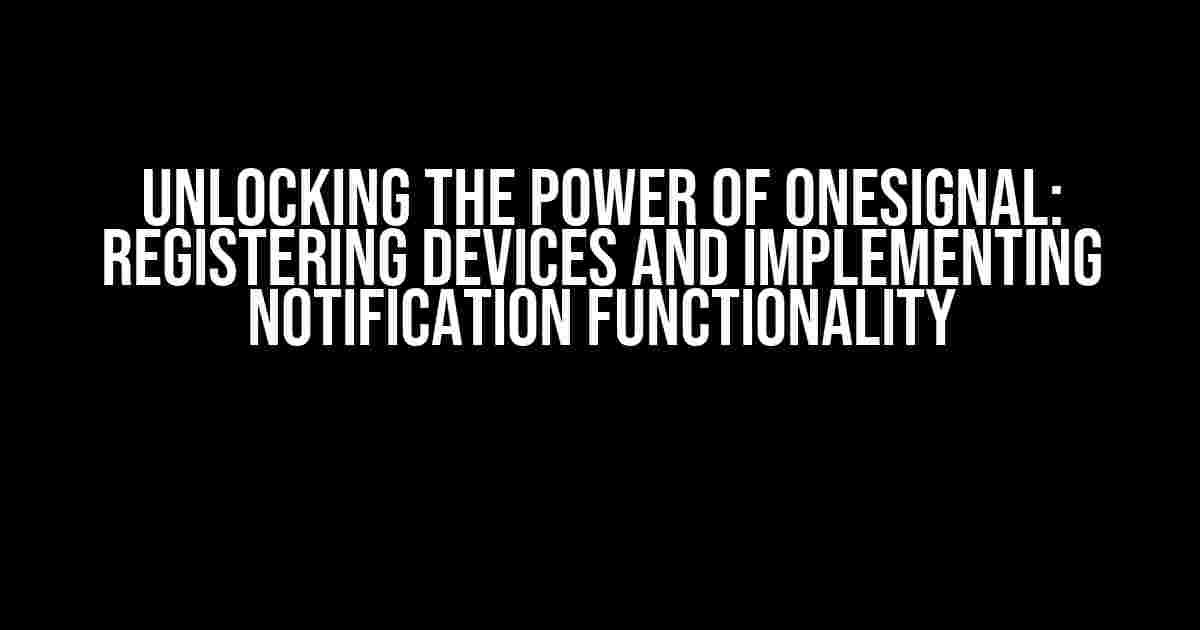Are you tired of dealing with complicated push notification services that leave your users feeling annoyed and your app abandoned? Look no further! OneSignal is here to revolutionize the way you communicate with your audience, and in this comprehensive guide, we’ll walk you through the process of registering devices and implementing notification functionality with ease.
What is OneSignal?
OneSignal is a powerful, flexible, and easy-to-use push notification service that allows you to reach your users across multiple platforms, including iOS, Android, web, and more. With OneSignal, you can create targeted, engaging, and personalized notifications that drive user engagement, increase retention, and boost conversions.
Why Choose OneSignal?
- Easy Integration**: OneSignal offers a simple, hassle-free integration process that gets you up and running in no time.
- Multi-Platform Support**: Reach your users across iOS, Android, web, and more, ensuring a seamless experience regardless of the device or platform.
- Personalization**: Craft targeted, tailored notifications that resonate with your audience, increasing engagement and driving results.
- Real-Time Analytics**: Get instant insights into your notification performance, allowing you to refine and optimize your strategy.
- Cost-Effective**: OneSignal offers a competitive pricing model that scales with your growth, ensuring you get the most bang for your buck.
Registering Devices with OneSignal
Before you can start sending notifications, you need to register devices with OneSignal. This involves obtaining an OneSignal API key, adding the OneSignal SDK to your project, and initializing the SDK.
Obtaining an OneSignal API Key
To get started, create an account on the OneSignal dashboard and follow these steps:
- Click on “New App” and fill in your app details.
- Choose your platform (iOS, Android, web, etc.) and follow the prompts.
- Copy your App ID and API Key, which will be used later in the integration process.
Adding the OneSignal SDK to Your Project
Next, you’ll need to add the OneSignal SDK to your project. The steps vary depending on your platform:
// For Android:
dependencies {
implementation 'com.onesignal:onesignal:4.3.0'
}
// For iOS (via CocoaPods):
pod 'OneSignal', '~> 3.0.0'
// For Web:
<script src="https://cdn.onesignal.com/sdks/OneSignalSDK.js" async></script>
Initializing the OneSignal SDK
To initialize the OneSignal SDK, you’ll need to add the following code to your project:
// For Android:
Onesignal.init(this, "YOUR_ONESIGNAL_APP_ID", "YOUR_ONESIGNAL_API_KEY");
// For iOS:
let onesignalInitSettings = [kOSSettingsKeyAutoPrompt: true, kOSSettingsKeyInAppLaunchURL: true]
OneSignal.initWithLaunchOptions(launchOptions, appId: "YOUR_ONESIGNAL_APP_ID", handleNotificationAction: { result in
// Handle notification actions
})
// For Web:
window.onesignal.init({
appId: "YOUR_ONESIGNAL_APP_ID",
subdomainName: "YOUR_ONESIGNAL_SUBDOMAIN",
safari_web_id: "YOUR_ONESIGNAL_SAFARI_WEB_ID",
autoRegister: true,
notifyButton: {
enable: true,
}
});
Implementing Notification Functionality
Now that you’ve registered devices with OneSignal, it’s time to implement notification functionality. OneSignal offers a range of features to help you craft engaging, targeted notifications that drive user engagement.
Creating Notifications
To create a notification, head to the OneSignal dashboard and follow these steps:
- Click on “New Notification” and enter your notification details (title, message, etc.).
- Choose your target audience (segments, filters, etc.).
- Schedule your notification (immediate, scheduled, or recurring).
- Click “Send Notification” to distribute your notification to your users.
Notification Types
OneSignal supports a range of notification types, including:
- Alerts**: Simple, text-based notifications.
- In-App Messages**: Rich, interactive notifications that appear within your app.
- Email Notifications**: Targeted email campaigns that drive engagement.
- Web Push Notifications**: Browser-based notifications that reach users even when they’re not actively using your app.
Notification Customization
OneSignal offers a range of customization options to help you craft notifications that resonate with your audience:
| Feature | Description |
|---|---|
| Segmentation | Target specific user groups based on demographics, behavior, or preferences. |
| Personalization | Use user data to create tailored, personalized notifications. |
| Notification Templates | Use pre-designed templates to create visually appealing notifications. |
| Analytics | Track notification performance and adjust your strategy accordingly. |
Conclusion
With OneSignal, registering devices and implementing notification functionality is a breeze. By following the steps outlined in this guide, you’ll be well on your way to creating targeted, engaging notifications that drive user engagement, increase retention, and boost conversions.
Remember, the key to success lies in understanding your audience, crafting personalized notifications, and continually refining your strategy based on real-time analytics. With OneSignal, the possibilities are endless – so what are you waiting for? Get started today and unlock the full potential of your app!
Frequently Asked Question
Get the inside scoop on OneSignal’s device registration and notification functionality!
What is device registration on OneSignal, and how does it work?
Device registration on OneSignal is the process of identifying and registering a user’s device to receive notifications. When a user grants permission, OneSignal assigns a unique identifier to the device, allowing you to send targeted notifications. This registration process typically occurs when a user installs your app or visits your website.
How do I integrate OneSignal’s device registration into my app or website?
Integrating OneSignal’s device registration is a breeze! For mobile apps, simply add the OneSignal SDK to your project, and for websites, add the OneSignal JavaScript library. Then, follow the documentation to initialize the OneSignal service and customize the registration process to fit your needs.
What types of notifications can I send using OneSignal?
The possibilities are endless! With OneSignal, you can send a wide range of notifications, including push notifications, in-app messages, email, and SMS. You can also customize the content, target specific audiences, and schedule notifications for optimal engagement.
Can I personalize notifications on OneSignal?
Absoluely! OneSignal allows you to personalize notifications based on user behavior, preferences, and demographics. You can use data tags, segmentation, and other features to create tailored messages that resonate with your audience.
How do I track the performance of my notifications on OneSignal?
OneSignal provides a robust analytics platform to help you measure the success of your notifications. You can track metrics such as delivery rates, open rates, click-through rates, and conversion rates to optimize your notification strategy and improve user engagement.
